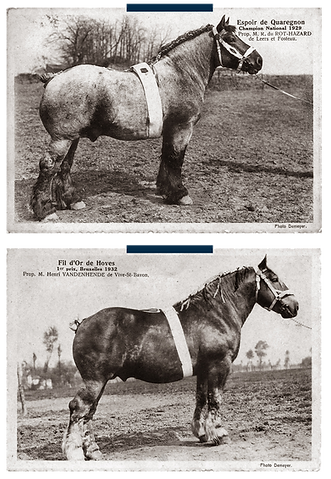BREED HISTORY

From as early as 5th century BC, a large confederation of tribes known as the Belgae were living in Northern Gaul, which is modern day France, Luxembourg, Belgium and The Netherlands. By 51 BC, the Roman empire defeated the Belgae tribes and Gaul fell to the Romans. The Belgae people, and their great horses, were discussed in depth by Julius Caesar in his many accounts of the Gaul wars. The Belgae’s massive horses were likely descended from ancient, ice age European heavy horses called the Forest or Diuvial Horse. These draft horses were so beloved by the Romans, they received honorable mention by Julius Caesar himself as, “most willing and untiring workers.” The Belgae people gave their name to the Roman province of Gallia Belgica and, much later, the country of Belgium. The Belgae’s great horses eventually acquired the moniker too.
For most of its history, Belgium was either part of a larger territory or divided into a number of smaller states, prominent among them being the Duchy of Brabant and the County of Flanders. During the Middle Ages, the region’s draft horses were known as the Flanders horse, Flemish horse and the Brabant horse. They were later combined to develop what we know as the "Belgian Draft." Today, these horses are simply referred to as Brabants. This can be confusing as these horses are bred in many regions outside the province of Brabant and even beyond the borders of Belgium. Throughout Europe, the breed is called the Belgian and Brabant, but they also have regionally specific names. For instance, in Northern Belgium, they’re called Belgisch Trekpaard, while in Southern Belgium they’re called Cheval de trait Belge or Brabancon. In Holland, they’re also known as Nederland Trekpaard or "Dutch Draft" and in France, they’re the Cheval Trait du Nord and Trait Ardennais.
Though the breed has been around in some form for over two thousand years, the breed studbooks are relatively new. The Belgian Department of Horses was established at the Liège Société des Eleveurs Belges in 1879, and a studbook in East Flanders was established in 1884. Five people took the initiative to establish a national studbook, the Société Nationale du Cheval de trait Belge, in 1886. This unity brought Brussels, Liège and East Flanders’ studbooks together. After 1887, they went by the name Société Nationale des Eleveurs Belges. Finally in 1890, the merged studbook was recognized by a ministerial letter on April 27, 1891, and on January 13, 1919, the Association received permission to call itself Royal. From then on, they became Koninklijke Maatschappij Het Belgisch Draft Horse. Other recognized studbooks are the Vlaamse Fokkers van het Belgisch Trekpaard, Association Wallonne du Cheval de Trait Belge and Eleveurs Wallons du Cheval de Trait Belge.
Given the breed’s sterling reputation for outstanding personalities and work ethic, they were used to develop many of the world’s modern day draft breeds to include, but not limited to: Pfalz-Ardenner, Soviet Heavy Draft, Lithuanian Heavy Draft, Swedish Ardennes, Rhenish German ColdBlood, Poitevin Mulassier, Auxois, Murakoz Horse, Czech Moravian Belgian Coldblood, Hungarian Draft Horse, Italian Heavy Draft, Jutland, Polish Coldblood, Breton Heavy Draft, American Belgian, American Brabant, Clydesdale, Shire, Suffolk Punch and Percheron.





